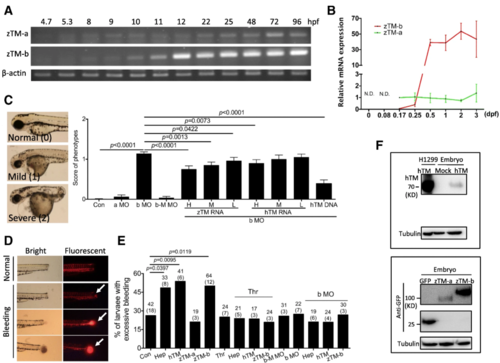Fig. 2
- ID
- ZDB-FIG-191021-12
- Publication
- Lee et al., 2019 - A thrombomodulin-like gene is crucial to the collective migration of epibolic blastomeres during germ layer formation and organogenesis in zebrafish
- Other Figures
- All Figure Page
- Back to All Figure Page
|
Zebrafish TM-b is functionally comparable to human thrombomodulin. Stage-dependent expression of zebrafish TM-like transcripts was examined by RT-PCR ( a) and real-time PCR ( b) with the cDNA prepared from the embryos of indicated stages. The relative mRNA expression levels were normalized with the mRNA levels of zebrafish β-actin and zTM-a at 0.17 dpf embryos by using 2-△△Ct method. c Zebrafish embryos were injected with MO specific to zebrafish TM-a (a MO, 0.92 pmol/embryo) or TM-b (b MO, 0.46 pmol/embryo) with/without co-injecting the plasmids expressing recombinant human TM (100 pg/embryo) or cRNA of zebrafish TM-b or human TM (H: 2130.8 pg/embryo; M: 1733.1 pg/embryo; L: 1155.4 pg/embryo) at 1 to 2-cell stages. Embryos injected with TM-b MO with five mismatched nucleotides (zTM-b mismatched MO) were used as the control for comparison. Larvae were examined at 3 dpf for survival and categorized into normal, mild and severe abnormal based on their gross morphology (left) and quantified (right). The categorization for mild and severe phenotypes was mainly based on the severity of heart edema and extent of trunk development: embryos displayed observable pericardial edema and body curvature were categorized as mild; whereas those displaying apparent pericardial edema and dorsalization were categorized as severe. d, e Control or experimental larvae at 3 dpf were injected with the indicated tested reagents with Texas red at common cardinal vein (CCV). Larvae were incubated at 28 °C for 30 min and amputated to remove tails before recording for their hemostatic activity. Larva displaying excessive blood leakage with more apparent diffusion of blood/Texas red from the wound, as compared with control larvae, was categorized as bleeding phenotype and recorded. The numbers on top of each column represent the total number of larvae tested (without parenthesis) in the total number of repeats (with parenthesis). f Embryos injected with plasmids encoding either human TM, zTM-a or zTM-b at 1 to 2-cell stages were harvested at 24 hpf and immunoblotting for the expression of recombinant TMs with anti-hTM antibodies (left) and anti-eGFP antibodies (right). The extracts of H1299 cells transfected with plasmids expressing human TM were served as a positive control. The tested reagents included: heparin (Hep; 57.5 ng/larva), thrombin (Thr; 23 μU/larva), plasmids encoding zebrafish TM-a (zTM-a; peGFP N1-zTM-a, 200 pg/larva for hemostatic assay and 460 pg/larva for Western blotting), plasmids encoding zebrafish TM-b (zTM-b; peGFP N1-zTM-b, 200 pg/larva for hemostatic assay and 920 pg/larva for Western blotting), zTM-b MO (b MO), zTM-b mismatched MO (b-M MO), and plasmids encoding human TM (hTM; pcDNA3.1-hTM, 100 pg/larva for hemostatic assay and 800 pg/larva for Western blotting) |
| Genes: | |
|---|---|
| Fish: | |
| Anatomical Term: | |
| Stage Range: | 50%-epiboly to Day 4 |
| Fish: | |
|---|---|
| Condition: | |
| Knockdown Reagents: | |
| Observed In: | |
| Stage: | Protruding-mouth |

